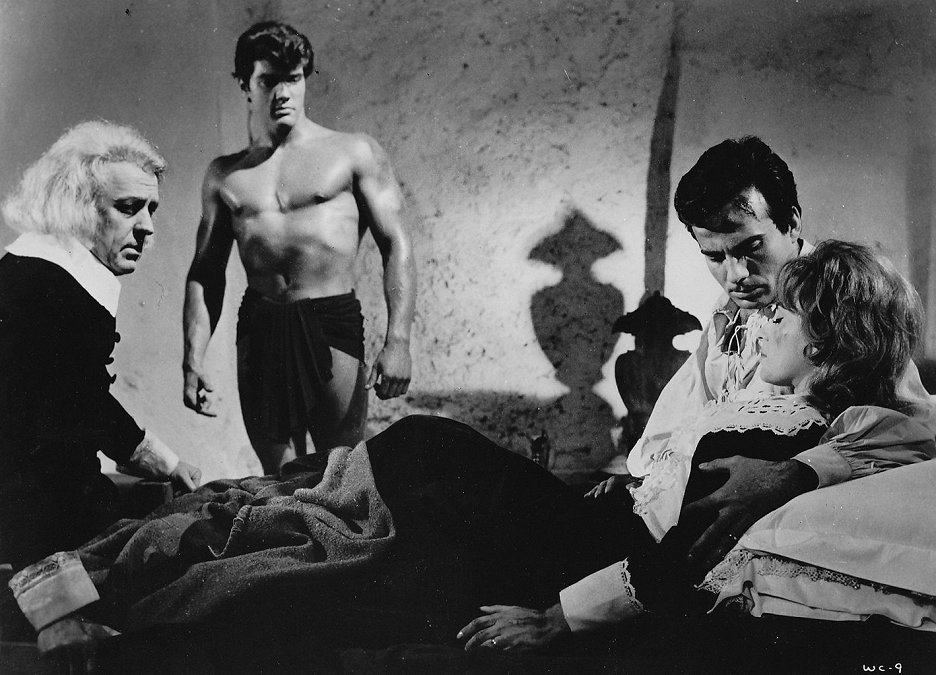Maciste all’inferno (Maciste in Hell), directed by Riccardo Freda, is a memorable entry in Italy’s “peplum” genre, a blend of myth, fantasy, and adventure. Known for bringing heroic tales to life with a mix of grandiosity and mystique, the peplum genre enjoyed significant popularity in Italy during the 1950s and 1960s. Maciste all’inferno stands out for its bold take on the classic myth of Maciste, a legendary strongman whose journey into Hell combines the elements of horror, ancient mythology, and epic adventure. This film uniquely incorporates supernatural and gothic themes, giving it a darker, atmospheric tone that sets it apart from more conventional sword-and-sandal films of its time.
Plot Overview: A Hero’s Descent into the Supernatural
The story follows Maciste (portrayed by Kirk Morris), who embarks on a dangerous journey to the underworld to rescue the beautiful Princess Laura. The princess has been cursed by demons and faces eternal suffering unless Maciste can defeat the dark forces that hold her captive. To save her, he must descend into Hell itself, confronting various demonic entities and supernatural threats in his quest to redeem her soul.
As he ventures through Hell, Maciste encounters an array of terrifying creatures and sinister landscapes, from fiery caverns to eerie, shadow-filled realms. Each encounter with Hell’s monstrous inhabitants tests both his physical strength and his will. The plot is simple but effective, following a classic hero’s journey that is enriched by its fantastical setting and mythic themes. This descent into Hell allows the film to explore themes of good versus evil, redemption, and the power of self-sacrifice in a way that elevates Maciste from a mere strongman to a mythic hero.
Kirk Morris as Maciste: A Hero of Strength and Virtue
Kirk Morris delivers a powerful performance as Maciste, embodying both the physical prowess and moral integrity that define the character. Morris, with his imposing physique and stoic demeanor, brings Maciste to life as a figure of unbreakable resolve and courage. Unlike many peplum heroes who rely solely on brute force, Morris’s Maciste is portrayed as a character motivated by compassion and loyalty. Traits that make his journey into Hell both admirable and emotionally resonant.
Morris’s portrayal is nuanced, as he captures both Maciste’s fearlessness and his moments of vulnerability. The character’s journey is not simply about conquering external foes but about confronting the inner strength required to face unspeakable horrors. His encounters with demonic beings showcase Morris’s ability to convey fear and determination, creating a portrayal that goes beyond mere heroism. Maciste’s quest in Hell reflects a personal trial that requires him to be both a warrior and a redeemer. A layered performance that adds depth to a typically action-driven genre.
The Setting: A Dark, Atmospheric Vision of the Underworld
One of the defining aspects of Maciste all’inferno is its setting—a vividly imagined version of Hell that is both eerie and grand. Director Riccardo Freda uses a mix of practical effects, atmospheric lighting, and creative set design to construct a Hell that is both terrifying and visually compelling. Unlike traditional peplum films that rely on sunny Mediterranean landscapes or opulent temples, Maciste all’inferno takes place in shadowed caverns, fiery pits, and smoke-filled passageways that capture the audience’s imagination and amplify the film’s horror elements.
The cinematography uses deep shadows, dim lighting, and smoky backgrounds to create a sense of otherworldly dread. Hell is depicted as a place of eternal night, where ominous red and black hues dominate, symbolizing the constant threat of darkness that Maciste must overcome. Freda’s vision of Hell is populated by creatures of the night—demons, witches, and tortured souls—that make each scene a haunting tableau, turning Maciste’s adventure into a journey through a gothic nightmare. These visual choices elevate Maciste all’inferno beyond traditional fantasy, giving it a unique place within the genre as a film that embraces horror-inspired aesthetics.
Themes: Courage, Redemption, and the Battle Between Good and Evil
At its core, Maciste all’inferno is a story about the eternal struggle between good and evil, courage and temptation. Maciste, as a figure of virtue, willingly risks his life to save another, embodying the ideals of heroism and self-sacrifice. His journey through Hell can be interpreted as a trial of his soul, with each demonic adversary representing a challenge to his integrity and resilience. The film delves into the themes of redemption and morality, as Maciste’s quest to rescue Princess Laura symbolizes a fight for salvation against forces that seek to corrupt and destroy.
The film also explores the idea of facing inner demons. Maciste’s trials in Hell are symbolic of the strength required to resist corruption and remain steadfast in the face of darkness. While many peplum heroes conquer physical challenges, Maciste all’inferno presents a hero who must also prove his moral strength, adding a layer of introspection rarely seen in the genre. Maciste’s journey reflects the universal human struggle to confront fears, temptations, and the unknown.
The Influence of Gothic and Horror Elements
Maciste all’inferno is unique within the peplum genre for its incorporation of horror and gothic elements. This stylistic choice was influenced by Italian horror cinema of the era, particularly the works of directors like Mario Bava. Freda’s decision to blend genres gives the film a haunting quality, setting it apart from more straightforward adventure films. The supernatural threats Maciste encounters echo classic horror tropes, making the film feel like a dark fairytale.
The eerie depictions of demons and witches add a supernatural layer that heightens the stakes, creating a sense of dread and suspense throughout Maciste’s journey. These gothic elements enhance the film’s exploration of the unknown, emphasizing the psychological and emotional challenges that come with facing unimaginable horrors. Maciste all’inferno stands as an innovative example of genre blending, paving the way for later Italian films that would continue to merge horror with adventure.
Legacy and Impact
While Maciste all’inferno may not be as widely recognized as other peplum classics. It has developed a cult following and is praised for its distinctive blend of fantasy, horror, and mythology. The film’s unique approach has made it a memorable entry in Italian genre cinema, appreciated for its atmospheric setting, strong central performance, and innovative take on the heroic journey. Fans of Italian horror and peplum alike find the film compelling for its stylistic flourishes and commitment to a dark, introspective version of the classic hero tale.
Today, Maciste all’inferno remains an example of Italian cinema’s willingness to experiment with genre and style. Mixing the thrill of ancient legends with the allure of the supernatural. Freda’s film resonates as both a gothic adventure and a tale of moral perseverance, a story where heroism is tested not only through feats of strength but by the courage to face one’s fears in the darkest of places. The film’s unique fusion of peplum and horror serves as a reminder of Italian cinema’s rich storytelling tradition. One that continues to captivate audiences with tales that transcend time and genre.
Watch the movie on Movieitaly+
Read more articles here!






